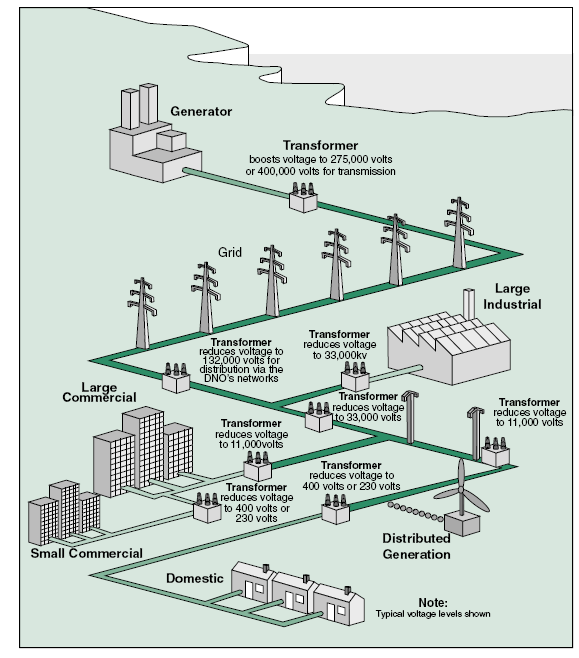Currently Used Tools for Distribution System Analysis
The status of simulation tools for distribution systems has been continuously evolving, especially in the recent few years. The increased penetration in DG systems on the distribution side has changed the conventional nature of the distribution network. The capabilities of distribution system analysis tools have been continuously evolving as well in order to keep up with the increasing complexity of the distribution networks. Different commercial software have been developed along side few open-source software that target various issues in distribution network analysis. The utility-level software have been focused on adding some features that account for DG integration studies. This section presents a short introduction of some of the commercial and open-source tools that are used in the utility and research communities.

distribution networks
a.Static and QSTS Simulators
Most commercial software that are used by utilities are design for handling common studies that are of interest to the utilities for performing their system operation, control and planning analysis. These tools provide functions that allow them to handle balanced and unbalanced multi-phase networks for various distribution system models. Such tools are mostly used for the standard static simulations such as power flow, voltage variations, limited harmonic analysis, standard fault current analysis, protection operations, and voltage regulator placement simulations . These tools offer very limited or zero time-series capabilities. However, recently some vendor have updated their functions in order to handle certain PV scenarios and have added some QSTS capabilities. All of these tool use frequency domain modeling and are focused mainly on static simulations. Some of the most prevalent commercial and open-source tools are discussed in this section. GridLAB-D. This is an open-source program developed by Pacic Northwest National Lab- oratory (PNNL) and is designed for handling simulation and modeling of distribution networks with smart grid technologies. The tool handles power ow and QSTS simulations on different scales and functions such as power system level, building energy level, market analysis and system data monitoring and control. This tool can solve three-phase unbalanced networks with demand response functions and storage and DG modeling capabilities. GridLAB-D also offers interfaces to existing simulation tools which allows for co-simulation capabilities. This tool also provides policy and economic analysis capabilities. OpenDSS. Open-source distribution systems simulator (OpenDSS) is an open-source tool developed by the Electric Power Research Institute (EPRI). It support steady-state analysis in the frequency domain for electric distribution networks. It supports the basic power ow, harmonic analysis, fault current calculation, and limited dynamic analysis. The dynamic analysis is limited to simple generator model with swing disturbance calculation. OpenDSS is mainly directed for QSTS analysis of networks with interconnected DG. CYMDIST. CYMDIST is one of the most widely used commercial simulation platforms for utility distribution networks. It provides basic capabilities that are of interest for utilities, such as static load ow and fault analysis. It also provides some options for reliability analysis and contingency analysis and QSTS simulation. Synergi Electric. Synergi is another commercial tool that is mostly used by utilities for static simulations. It is a power distribution system planning and analysis tool for the electric grid. handles reliability and safety analysis, and it can be interfaced with data integration tool in order to import Geographic Information Systems (GIS) data and Supervisory Control and Data Acquisition (SCADA) data. It has limited capabilities for simulation of networks with DG interconnections. It is mainly used for static and QSTS simulation. New functions are being introduced for handling simple Volt-VAr optimization, fault location analysis, optimal switching and contingency analysis.

Synergi Electric
b.Dynamic and Transient Analysis Programs
Dynamic and transient analysis programs operate in a very different manner than static and QSTS programs. Such programs are mainly used for transmission level applications due to the computational complexity involved in dynamic and transient solutions. These programs are now being used for limited applications in distribution network simulations as the penetration of power electronic-interfaced DG increases on the distribution side. Electromagnetic Transient Program (EMTP). is considered as a main reference for EMT simulations. It was developed in the 1960s and was improved over the years through utility and electric power organizations’ inputs and suggestions. The current version EMTP-RV is still one of the most used EMT analysis tools. PSCAD/EMTDC. is another EMT tool that uses similar approach to EMTP. It is also mostly focused on transmission level applications. Mainly it supports multi-phase unbalanced networks for harmonic and transient analysis. PSCAD is more used in the university and research environment. PSS/E. is a transient analysis commercial tool provided by Siemens. It is not as detailed as conventional EMT tools. However, it is very accurate and effcient for certain dynamic applications. It is mainly used for transmission system analysis and planning. It can handle large unbalanced networks, lightning analysis, steady-state contingency analysis, and fault analysis.

